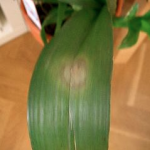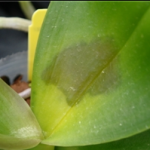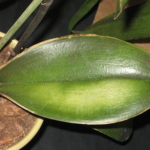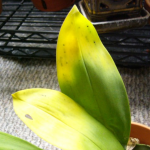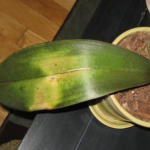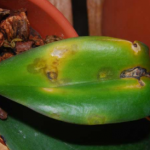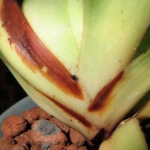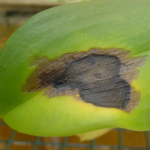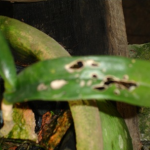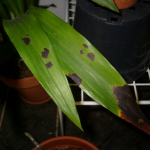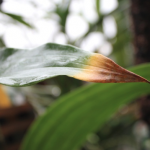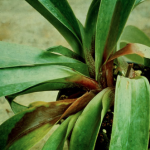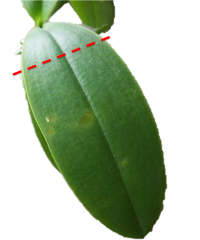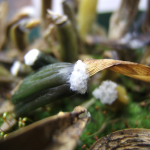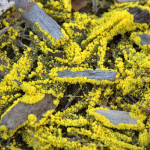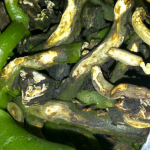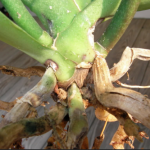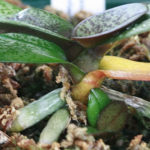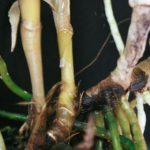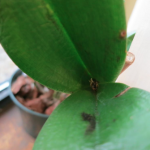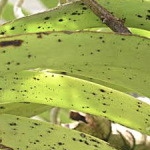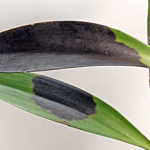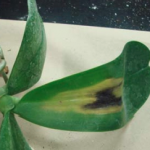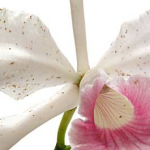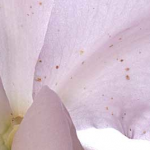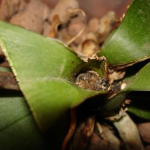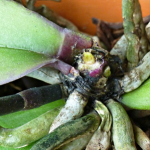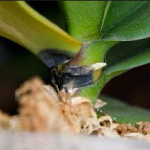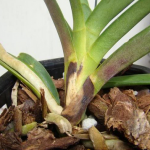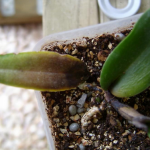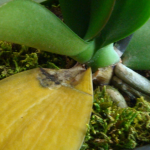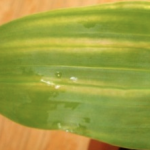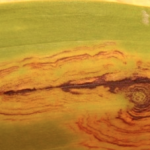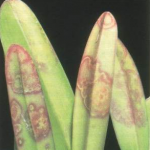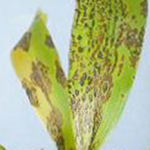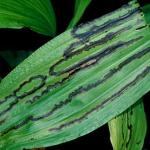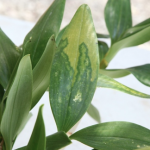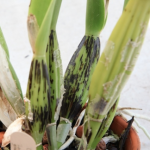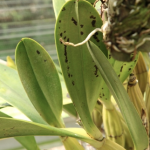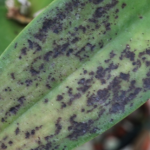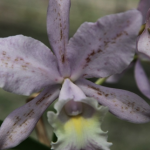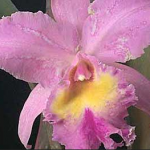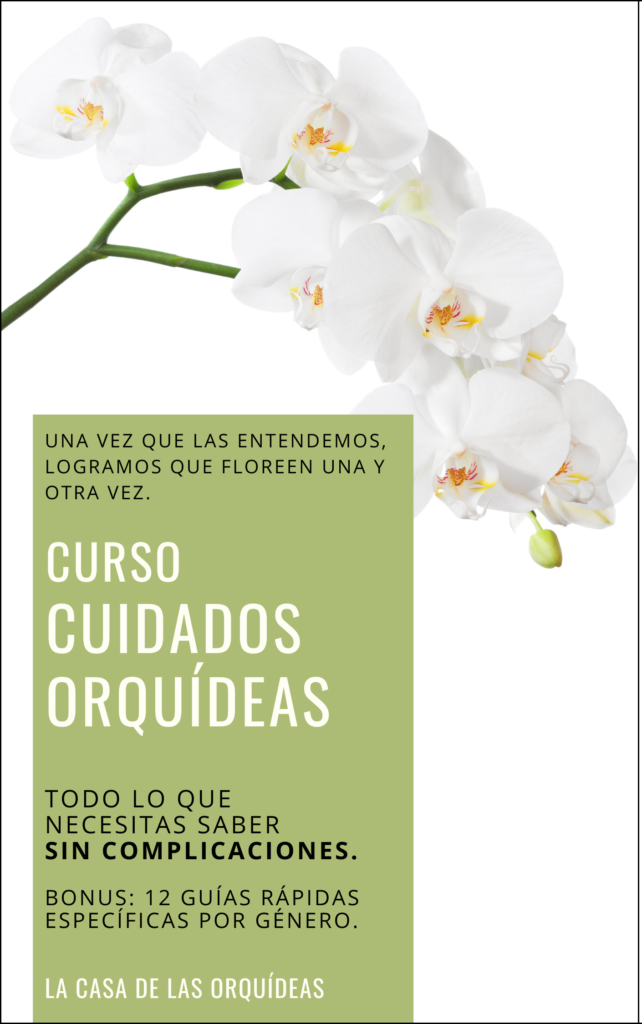+ Spanish
The best thing we can do is try to prevent pests and diseases! Here are some prevention tips:
– Always water with room temperature water in the morning. This way the plant has enough time to dry before the temperature starts dropping in the afternoon.
– Whenever you need to do surgery to your plants always use sterilized scissors or cutters; cauterize the wound immediately with cinnamon or our multi-purpose spray (see Home Remedies) to avoid fungal or bacterial infections.
– When you repot an orchid because it has been sick, be sure to wash and disinfect the pot if you’re going to reuse it and though away the old media, use new one. If you’re using inorganic media disinfect it by soaking it in a bleach solution (Home Remedies) before reusing it again.
– Observe your plant frequently, even the underside of the leaves: at the first sight of something odd, be quick to find out what it is and treat it before the sickness / pest infestation expands to all your plant, or worse, all your collection.
– QUARANTINE: any new plant that comes into your home has to have a quarantine period apart from the rest of your plants and under observation; this way, if it is sick or has any pests they won’t spread to your healthy plants. You can welcome your new addition by giving it a very good mist of our multi-purpose spray, just to be safe.
Here are some of the most common diseases:
bacterial infections
There are several types of bacteria that attack orchids. We are going to group the as one because the symptoms are similar and the treatments are the same.
symptoms: if notice that there are yellow or light brown spots appearing in your leaves, that have a defined yellow halo, your plant has some kind of bacterial infection. Spots can also begin as discolorations that extend changing to a brown or blackish color, with a rotten appearance and a bad oddor. By this time, it’s probable that the infection has spread to the pseudobulbs, roots and rhizome. Infections spread really fast and they can kill your plant.
prevention: bacteria manifests itself when there’s excess water and very poor aeration, it’s more frequent in the warm months. Always water in the morning, being careful not to leave water deposits in the leaves or the joints, more so in the crown. Never water over the plant, water over the media! If you see any water pools, dry them up with a cotton swap or Qtip, or blow strongly to eliminate this water deposits. Worm tea sometimes helps prevent bad bacteria when sprayed on the plant every 15 days.
TIP: use a thin straw to blow out the water deposits in complicated joints
Also we have to be careful not to infect a healthy plant. If you have to do cuts or surgery to your plant, always use disinfected tools between cuts, more so from one plant to the next and cauterize the wounds; open wounds are focus of infections.
fungal infections
Just like bacterial infections, we’ll group all fungal infections.
symptoms: fungi generally attacks the roots, rhizomes and pseudobulbs first, meaning the lower part of the plant. The leaves will yellow and will also present spots in some cases
Some of the spots are similar as the ones produced by bacteria, others are elongated and their color is dark purple or blackish. They can appear on the surface of the leaves or on the underside of them. The spots can present sags. In the flowers, it shows as little black or brown spots; these can extend thtoughout the flower until it’s completely covered by them.
TIP: to be able to determine if you have a fungal or bacterial disease, is mandatory to observe the roots. If you find that they are rotten or in bad shape, you are dealing with a fungal infection.
prevention: the factors that foster the development of fungi and that you must avoid are:
– organic media decomposing
– poor draining media or pot, therefore the bottom of the plant stays constantly wet
– not enough light and aeration
– higher temperatures
treatment: it’s vital that you cut the infected parts. Cut 1 or 2” above the spot and cauterize. Apply a systemic fungicide to the rest of the plant. Increase the air movement (you can use an oscillatory vent), increase the light (you can use artificial LED light).
TIP: use Lisetrine (yes, the mouth wash) directly on the fungus; it’s antimycotic properties are very effective!!
home remedy: we have a lot!! Please chech out our Home Remedy section.
Crown Rot
This disease is caused by fungal infection and it’s quite serious, serious enough to kill your plant. It’s caused when water deposits are formed in the crown (where the leaves grow forming a kind of cup that can store water) and low temperatures. The symptoms are a rapid change on all the leaves withering and turning yellow first, and then turning black and falling off. This process can happen overnight.
The genus mostly affected by this disease are Phalaenopsis, Phragmapedium and Paphiopedilum, but it can occur in any orchid where the leaves form a crown or a kind of water storage; this happens when new leaves grow within the old leaves.
The older leaves, the ones in the bottom will yellow, wither and fall off. This is normal!! The issue becomes clear when all the leaves are going through this process and you start to see black tissue on the base of the leaves.
prevention: please read our article “How should I water my orchids?“!! Crown rot can be easily avoided if we water our plants correctly.
treatment: you have to cut and cauterize all the affected parts, sometimes including part of the crown. You should apply Hydrogen Peroxide undiluted and freely daily during the first week of treatment and let your orchid dry outside the pot and any growing media, bare root. Repeat until the Hydrogen Peroxide stops bubbling (bubbles are a sign of infection) and repot whatever is left of the plant and resume normal care.
Most of the times, once the infection has reached the core of the crown, the damage is too much and the plant will die. But if it is detected on time, there is hope!! Remember to always inspect your orchids and act fast at the first sign that something is not ok!!
If you rather bring out the big guns from the start, you can apply chemical fungicides such as: Phyton 27, Subdue Maxx, Cleary…
viral infections
symptoms: the leaves, and some times the flowers, show discolorations and black spots formed in groups or forming patterns or very distinctive forms, similar to mosaic drawings or wood grain.
prevention: virus spread from plant to plant through their sap. It’s very important to disinfect and sterilize all your utensils and cutting tools. If one of your plants present signs of virus, separate it immediately from the rest of your plants and burn it.
Sadly, there is no cure for virus infections.

